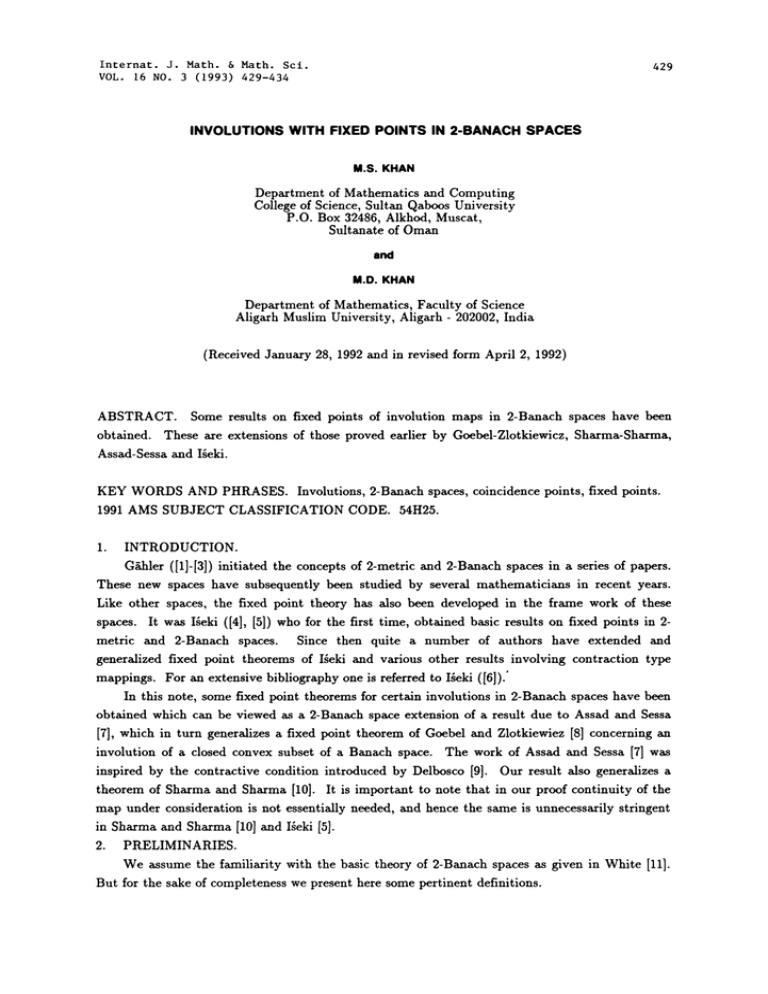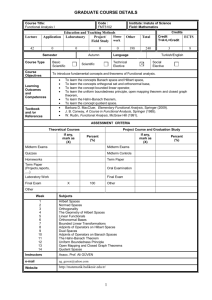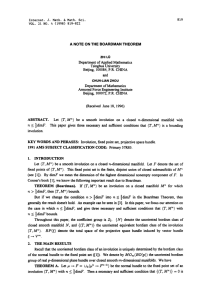SPACES INVOLUTIONS WITH FIXED POINTS IN Department
advertisement

Internat. J. Math. & Math. Sci.
VOL. 16 NO. 3 (1993) 429-434
429
INVOLUTIONS WITH FIXED POINTS IN 2-BANACH SPACES
M.S. KHAN
Department of Mathematics and Computing
College of Science, Sultan Qaboos University
P.O. Box 32486, Alkhod, Muscat,
Sultanate of Oman
and
M.D. KHAN
Department of Mathematics, Faculty of Science
Aligarh Muslim University, Aligarh- 202002, India
(Received January 28, 1992 and in revised form April 2, 1992)
ABSTRACT. Some results
on fixed points of involution maps in 2-Banach spaces have been
obtained. These are extensions of those proved earlier by Goebel-Zlotkiewicz, Sharma-Sharma,
Assad-Sessa and Ieki.
KEY WORDS AND PHRASES. Involutions, 2-Banach spaces, coincidence points, fixed points.
1991 AMS SUBJECT CLASSIFICATION CODE. 54H25.
1.
INTRODUCTION.
Ghler ([1]-[3]) initiated the concepts of 2-metric and 2-Banach spaces in a series of papers.
These new spaces have subsequently been studied by several mathematicians in recent years.
Like other spaces, the fixed point theory has also been developed in the frame work of these
spaces. It was Ieki ([4], [5]) who for the first time, obtained basic results on fixed points in 2metric and 2-Banach spaces. Since then quite a number of authors have extended and
generalized fixed point theorems of Ieki and various other results involving contraction type
mappings. For an extensive bibliography one is referred to Ieki ([6]).*
In this note, some fixed point theorems for certain involutions in 2-Banach spaces have been
obtained which can be viewed as a 2-Banach space extension of a result due to Assad and Sessa
[7], which in turn generalizes a fixed point theorem of Goebel and Zlotkiewiez [8] concerning an
involution of a closed convex subset of a Banach space. The work of Assad and Sessa [7] was
inspired by the contractive condition introduced by Delbosco [9]. Our result also generalizes a
theorem of Sharma and Sharma [10]. It is important to note that in our proof continuity of the
map under consideration is not essentially needed, and hence the same is unnecessarily stringent
in Sharma and Sharma [10] and Ikeki [5].
2. PRELIMINARIES.
We assume the familiarity with the basic theory of 2-Banach spaces as given in White [11].
But for the sake of completeness we present here some pertinent definitions.
M.S. KHAN AND M.D. KHAN
430
The following notions are essentially due to Ghler [1].
DEFINITION 2.1. Let x be a linear space, and .,-II be a real-valued function defined on
x. Then the pair (x II-,. II) is called a linear 2-normed space if, for a,b,c C X,
a,b -0 if and only if a and are linearly dependent,
(i)
b, a II,
a, b
(ii)
being real,
(iii) a,b
I1 a,b II,
(iv) Ila, b+cll_< Ila, bll+lla, cll.
Here .,-II is called a 2-norm and is a non-negative function.
DEFINITION 2.2. A sequence {Zn} in a linear 2-normed space X is called a convergent
aequence if there is an element z e X such that the I,/ xn- z,
0 for all
converges to-z, we write zn---,z and call z the limit of {xn}. Of course, here dimX _> 2 otherwise
every sequence of points in such a space would converge to every point of the space.
DEFINITION 2.3. A sequence {zn} in a linear 2-normed space X is called a Cauchy
X.
0 for every
sequence if m,limn--,o tm in,
DEFINITION 2.4. A linear 2-normed space in which every Cauchy sequence is a convergent
sequence is called a 2-Baaach apace.
We also need the following notion from Assad and Sessa [7].
Let be the family of continuous functions :ta+--.+, (where t+ stands for the set of nonnegative reals) satisfying the following conditions:
3.
(i) @(1,1,1) k < 2,
(ii) for s _> 0,t _> 0, the inequality s <_ (t,2t, s) implies that s _< :t.
RESULTS.
Throughout this section, X stands for a 2-Banach space with dimX >_ 2, and I denotes the
identity map on x.
THEOREM 3.1. Let T be a self-mapping of X and
such that
(A) T2= I,
Tz- Ty, a < @( z- y,a [[, z Tz, a [[, y- Ty, a ), for all z,y,a in X. Then T has at
(B)
least one fixed point.
PROOF. Let z be an arbitrary point in X. Put y
+ z), z Ty and u 2y- z. It is
easy to observe that
Tz
2 Tz
Tz, a
I1, a
2
,, II.
Now we have
z,.
T2:
T!l,a
< ( Tz -//,a II, Tz
(
=
Y, a
II, 2
=
T2z, a II,
Y, a
II,
V- Tll, a [[)
Y- Ty, a
and also
<(
(
- y,. II,
y,.
II, 2
Tx, a II, v- Ty, a II)
y,. II,
v- Ty, a
INVOLUTIONS WITH FIXED POINTS IN 2-BANACH SPACES
On the other hand,
we
431
have
Hence
By the hypothesis (ii),
Let
we obtain
(Tr + t), for y z in X.
us put Gr
Then by the foregoing inequMity, we get
Y
for M1
T, a
,. in X.
Now, for
bitry
int % i X, le
ao a_ 1,n
1,2,
I] m
n
1, then
Gmzo-Gnzo, a
=m- =.,a
IIGmzo-Gm-Zo, all +... + G"+ ;zo-G%o, all
/2 Go .o,a II.
From this, it follows that {} is a Cauchy sequence which converges in x. Put z*= Iz,.
5
ow consider
z* -Gz*,a II
<-
z*
.
+
+ II Gzn-Gz*,a
,a
IIx*-xn+ 1,all +1/211xn-*,all +1/211Tn-Tx*,all
< I1*-%+ 1,11 +ll=.-t*,all +(ll.-t*,all, II.Tzn, all, II*-T=*,all)
_<
I1=*-=+ ,11 +11=-*,11 +(ll==-=*,ll,211(G=-=),ll,211(=*-G=*),ll)tting n, we get
2
So agn by condition (ii),
we
*-G=*,all 5 (0,0,2 II =*-G=*, II ).
get
-G*,a
0, for fll a in X.
Hence, (z*-Gz*) d a e linely dependent for M1 a in X. Since dimX 2, the only way
(r*-Gz*) c be linely dependent with M1 a in X, is that z*-Gz*=0. Hence r*= Tz*
required. This completes the prof.
M.S. KHAN AND M.D. KHAN
432
be such that T 2 I and
I[Tz-Ty, a[ <_a[[z-y,a[I +/(l[z-T,all + Ily-Ty, al[),
for all z,y,a in X, where a _> 0,/ > 0 and a+4/ <2. Then T has at least one fixed point.
PROOF. The condition (3.1) implies that
_<
+
COROLLARY 3.1 (Sharma and Sharma [10]). Let
( + 2) 2
Now if we sume that
,- y, II,
II
-
T:X--,X
(3.1)
T, II, Y- Ty, }.
then, by Theorem 3.1, T h at let one fixed point. This completes the prof.
REMARKS.
(a) A critical observation of the prf of the mMn threm in Sharma d Shma [10],
reveMs that they have used the continuity of the involution map but fMled to mention the se.
However, in out prf this additioaM contion is not required.
(b) When x is the usuM Bh space, Corolly 3.1 reduced to a threm of Ieki [5]. In
a private communication Profesr Ieki agrd that the continuity of the involution map is
essentiMly nded for his prf to hold.
COROLLARY 3.2. Under the hypothesis of Threm 3.1, suppose, in addition, that at let
one of the following strict inequMity holds:
* T, < * , + T, II,
* ,a < * T,a + Tz ,a
for all and { *) in x. Then is the unique fixed point of T.
*
PROOF. By Theorem 3.1, T* *. Suppose also that Ty* y* for some y*
that
* y*. Then using (3.2}, we have
a
a
a
(3.2)
a
II*-y*,=ll
X. A .ume
II*-Ty*,=II < II*-y*,=ll + IlY*-Ty*,all
which is impossible. Therefore, *=y*. Similarly, other condition in (3.2) also implie., that
x* y*.
Now, we apply Theorem 3.1 to obtain a coincidence theorem.
THEOREM 3.2. Let T and 5’ be the self-mappings of x, and
such that the following
hold:
I,S2 I, TS ST,
11T Ty, a < ( S- Sy, II, S- T,a II, Sy- Ty, a ), for all t,y,a in X. Then
there exists at least one point to in x such that Tto Sto.
PROOF. It follows from Theorem 3.1 that TS has at least one fixed point %. Then clearly
T% S%. This completes the proof.
REMARK. In case, one assumes some additional conditions on TS, as in Corollary 3.2, then
t o in Theorem 3.2 becomes the unique fixed point of TS. Then, commutativity of T,S and the
uniqueness of to can be used to show that Zo is actually a common fixed point of S and T.
Further, if S and T satisfies conditions similar to one in Corollary 3.2, then their common fixed
point t o is also unique.
(i)
(ii)
T2
INVOLUTIONS WITH FIXED POINTS IN 2-BANACH SPACES
433
ACKNOWLEDGEMENT. The first author is grateful to Professor S. Sessa for supplying the
preprint of
[7],
which motivated the present study.
REFERENCES
1.
2.
G/i, HLER, S., Lineare 2-normierte Riume, Math. Nachr. 28 (1965), 1-43.
2-metrische R/iume und ihre topologische Strucktur, Math. Nachr. 26 (1963).
G,HLER, S.,
115-148.
G/HLER, S., 0bet die uniformisierbarkeit 2-metrischer R/iume, Math.
Nachr. 28 (1965),
235-244.
4.
K., Fixed point" theorems in 2-metric spaces, Maths Seminar Notes, Kobe Univ. 3
(1975), 133-136.
5.
K., Fixed point theorems in Banach spaces, Maths Seminar Notes, Kobe Univ. 2
(1976), 11-13.
6.
K., Mathematics on 2-normed spaces, Bull. Korean Math. So. 13 (2) (1977), 127135.
7. ASSAD, N.A. & SESSA, S., Involution maps and fixed points in Banaeh spaces, Math. J.
Toyama Univ. 14 (1991), 141-146.
8. GOEBEL, K.
ZLOTKIEWICZ, E., Some fixed point theorems in Banach spaces,
Colloq. Math. 23 (1971), 103-106.
9. DELBOSCO, D., A unified approach to all contractive mappings, Jfianabha 16 (1986), 1-11.
’10. SHARMA, P.L. & SHARMA, B.K., Non-contraction type mappings in 2-Banach spaces,
Nanta Math. 12 (1) (1979), 91-93.
11. WHITE, A.G., 2-Banach spaces, Math. Nachr. 42 (1969), 43-60.
3.
IEKI,
I;EKI,
IEKI,
z





